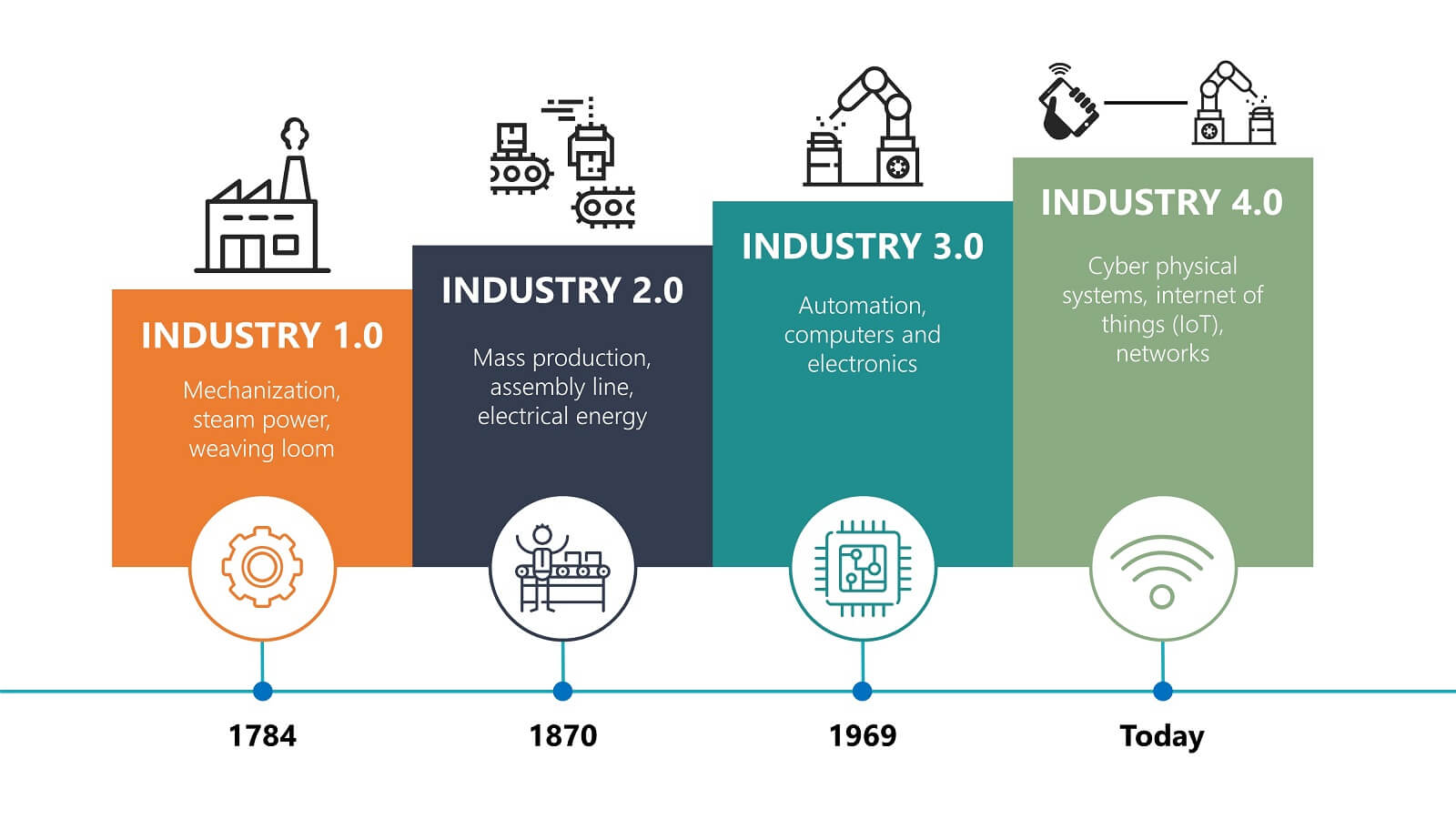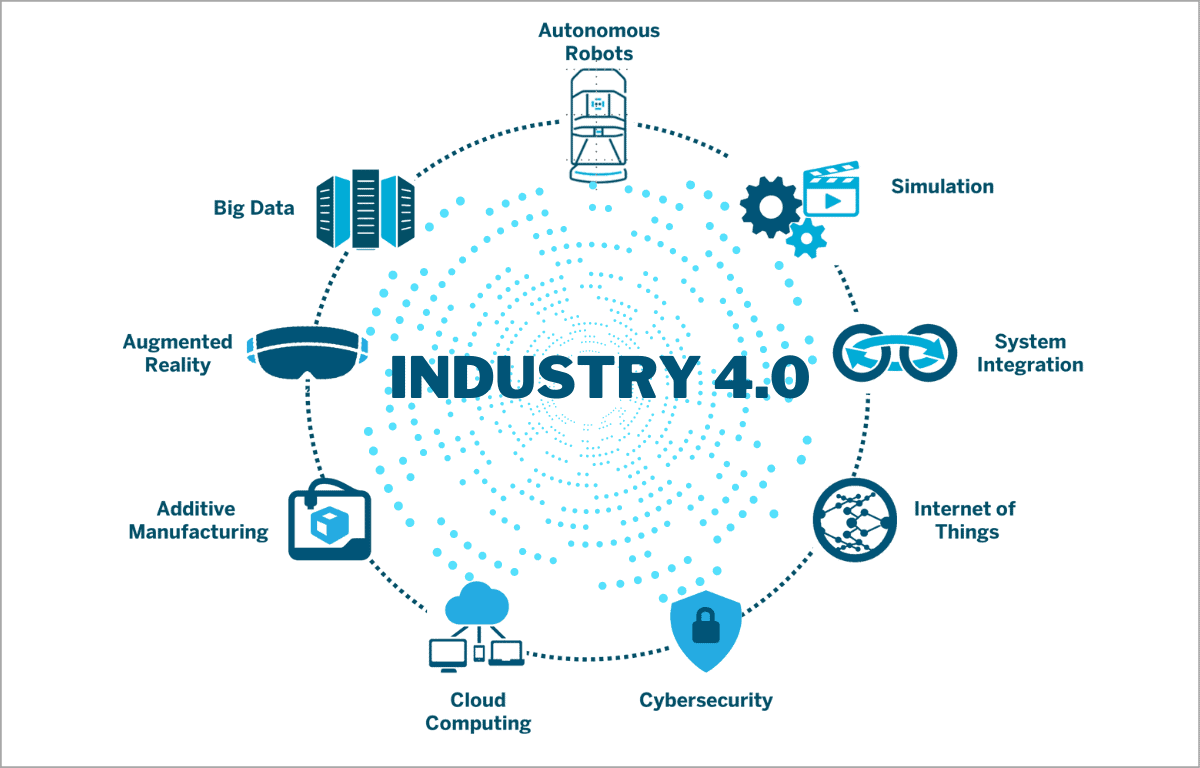In today’s highly connected world, technology is transforming every aspect of our lives, including the industrial sector. One of the latest trends in this space is Industry 4.0, which combines traditional manufacturing practices with cutting-edge smart technology. This article delves into the concept of Industry 4.0, its historical context, key features, and its potential impact on businesses and the economy.
Evolution of Industry: From 1.0 to 4.0
To understand Industry 4.0, let’s first explore its historical predecessors. The first industrial revolution occurred in the 19th century, when Britain transitioned from an agrarian society to a factory-based one. The second industrial revolution, spanning from the 1850s to World War I, brought about the introduction of steel and electrification, paving the way for mass production. The third industrial revolution, which took place from the late 1950s to the late 1970s, ushered in the digital age.
Industry 4.0 represents the fourth industrial revolution and is characterized by the digitization of manufacturing processes. It leverages the Internet of Things (IoT) and cyber-physical systems to collect and analyze vast amounts of data, enabling manufacturers to optimize their operations and improve productivity.
The Core Principles of Industry 4.0

Industry 4.0 is built upon several core principles that drive its transformative power. These principles include:
-
Interconnectivity: Industry 4.0 relies on the seamless integration of machines, devices, and systems through the IoT. This allows for real-time data exchange and communication, enabling smart decision-making and automation.
-
Information Transparency: Through the use of sensors and advanced analytics, Industry 4.0 provides unprecedented visibility into the manufacturing process. This transparency allows manufacturers to monitor and analyze the entire value chain, identifying areas for improvement and optimization.
-
Technical Assistance: Industry 4.0 leverages technologies such as artificial intelligence (AI) and machine learning to provide technical assistance to human workers. Smart machines can analyze data, diagnose issues, and even make autonomous decisions, freeing up human workers for more complex tasks.
-
Decentralized Decision-making: Industry 4.0 empowers individual machines and systems to make decentralized decisions based on real-time data. This enables faster response times, greater flexibility, and improved overall efficiency.
The Role of Government in Driving Industry 4.0
Industry 4.0 is not solely driven by private companies; governments play a significant role in its advancement. In 2013, the German government introduced the concept of “Industrie 4.0” in a high-tech strategy document. Chancellor Angela Merkel further popularized the term in 2015, emphasizing its potential to bridge the gap between online and industrial production.
Governments worldwide are investing in research and development to accelerate the adoption of Industry 4.0. For instance, Germany has committed approximately €200 million to support academia, businesses, and government initiatives. In the United States, the Smart Manufacturing Leadership Coalition (SMLC) aims to create an open, smart manufacturing platform to facilitate the transition to Industry 4.0.
The Value of Industry 4.0
The potential economic value of Industry 4.0 is immense. According to KPMG, the component markets of Industry 4.0 are estimated to be worth over US$4 trillion by 2020. This surpasses the projected value of the IoT market, which is estimated to reach nearly US$3.7 trillion by the same year.
Adopting Industry 4.0 technologies can significantly benefit businesses and economies. A government report suggests that embracing advanced technologies could add £445 billion to the UK’s manufacturing sector and create around 175,000 jobs. Real-time data analytics and increased automation can lead to higher productivity, cost reductions, and improved overall efficiency.
Key Challenges and Concerns

While Industry 4.0 offers numerous advantages, it also presents challenges and concerns that need to be addressed. Some of the key challenges include:
-
Security: With increased interconnectivity and reliance on digital systems, the risk of cyber threats and data breaches becomes more significant. Robust cybersecurity measures are crucial to safeguard critical infrastructure and sensitive information.
-
Skills Gap: The adoption of Industry 4.0 technologies requires a workforce equipped with the necessary skills. Upskilling and reskilling programs are essential to ensure a smooth transition and maximize the potential benefits of this new industrial era.
-
Ethical Considerations: As machines become increasingly autonomous, ethical considerations arise. Clear guidelines and regulations are necessary to address the implications of AI and machine decision-making, ensuring that ethical standards are maintained.
-
Infrastructure: Industry 4.0 relies heavily on advanced infrastructure, including high-speed internet connectivity and reliable communication networks. Ensuring widespread access to these technologies is crucial for a successful transition.
Industry 4.0 in Practice: Real-World Applications
Industry 4.0 is already making waves in various sectors. Here are a few examples of its real-world applications:
-
Smart Manufacturing: Smart factories leverage Industry 4.0 technologies to optimize production processes and improve quality. With interconnected machines, real-time data analytics, and AI-driven automation, manufacturers can achieve higher efficiency and flexibility.
-
Supply Chain Management: Industry 4.0 facilitates end-to-end visibility and traceability in supply chains. IoT sensors and advanced analytics enable real-time monitoring of inventory, logistics, and demand, allowing for proactive decision-making and optimized resource allocation.
-
Predictive Maintenance: By leveraging IoT sensors and machine learning algorithms, Industry 4.0 enables predictive maintenance. Machines can detect potential faults or anomalies, allowing for timely maintenance and minimizing downtime.
-
Product Customization: Industry 4.0 enables mass customization by leveraging data-driven insights. Manufacturers can tailor products to individual customer preferences, delivering personalized experiences at scale.
Embracing Industry 4.0: The Road Ahead

To fully embrace Industry 4.0, businesses must take proactive steps towards digital transformation. Here are some key considerations for a successful transition:
-
Develop a Digital Strategy: Define clear goals and objectives for adopting Industry 4.0 technologies. Conduct a comprehensive assessment of existing capabilities and identify areas for improvement.
-
Invest in Infrastructure: Ensure that the necessary infrastructure, such as high-speed internet connectivity and robust communication networks, is in place to support Industry 4.0 initiatives.
-
Upskill and Reskill the Workforce: Provide training and education programs to equip employees with the skills needed to thrive in the era of Industry 4.0. Foster a culture of continuous learning and innovation.
-
Collaborate and Share Best Practices: Industry 4.0 requires collaboration across organizations and sectors. Share best practices, lessons learned, and success stories to accelerate the adoption of these technologies.
Conclusion
Industry 4.0 represents a new era of manufacturing, driven by the digitization of processes and the integration of smart technologies. With its potential for increased automation, improved productivity, and enhanced decision-making, Industry 4.0 offers significant opportunities for businesses and economies worldwide. However, it also presents challenges that need to be addressed, including cybersecurity, skills gaps, ethical considerations, and infrastructure requirements. By embracing Industry 4.0 and taking proactive steps towards digital transformation, organizations can position themselves for success in the fourth industrial revolution.
